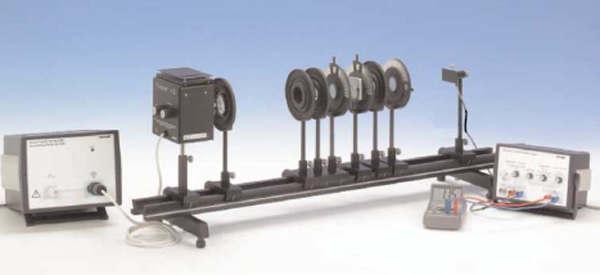Polarisation through quarter-wave plates

Monochromatic light falls on a mica plate perpendicular to its optic axis. At the appropriate plate thickness (lambda/4, or quarter-wave plate) there is a 90° phase shift between the ordinary and the extraordinary ray when the light emerges from the crystal. The polarisation of the emergent light is investigated at different angles between the optic axis of the lambda/4 plate and the direction of polarisation of the incident light.
- the principles Polaroid glasses work on
- discover ways to modify certain attributes of light
- make the electric vector go round and round
Lens holder
Condenser holder
Lens, mounted, f +100 mm
Iris diaphragm
Double condenser, f = 6 cm
High pressure Hg Lamp, 50 W
Optical bench expert, l = 1000 mm
Base for optical bench expert, adjustable
Slide mount for optical bench expert, h = 30 mm
Slide mount for optical bench expert, h = 80 mm
Interference filter, yellow, 578 nm
Polarising filter, on stem
Polarization specimen, mica
Si-Photodetector with Amplifier
Control Unit for Si-Photodetector
Power supply 230 V/ 50 Hz for 50 W-Hg-lamp
Digital multimeter 2005
Connecting cord, 32 A, 750 mm, red
Connecting cord, 32 A, 750 mm, blue
Adapter, BNC-plug/socket 4 mm
Diaphragm holder, for beam height 120 mm
- To measure the intensity of plane polarised light as a function of the position of the analyser.
- To measure the light intensity behind the analyser as a function of the angle between the optic axis of the lambda/4plate and that of the analyser.
- To perform experiment 2. with two lambda/4 plates one behind the other.
- Plane
- Circularly and elliptically polarised light
- Polariser
- Analyzer
- Plane of polarisation
- Double refraction
- Optic axis
- Ordinary and extraordinary ray
